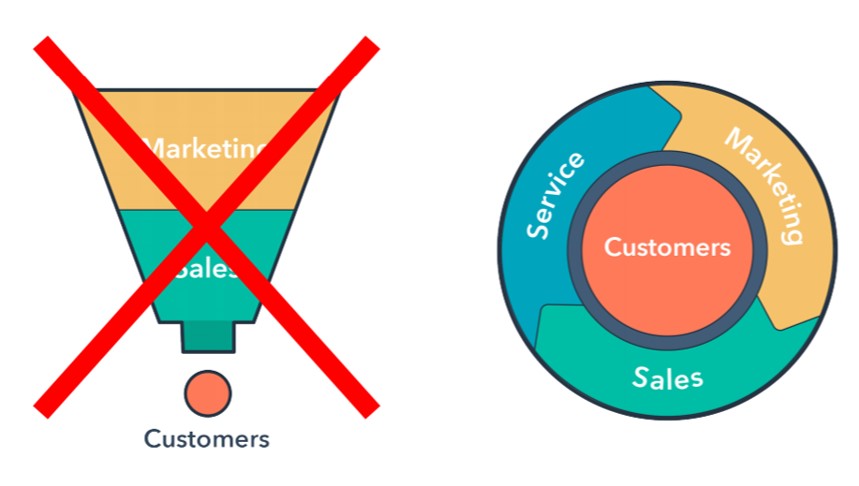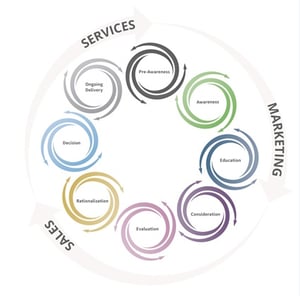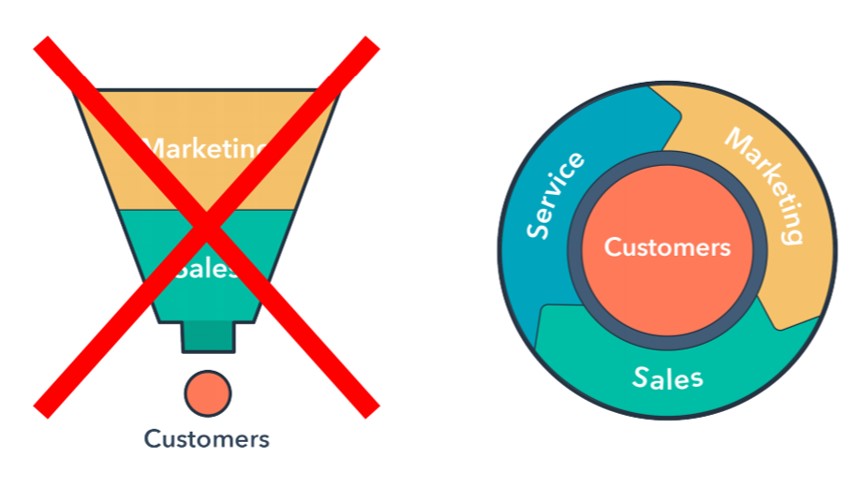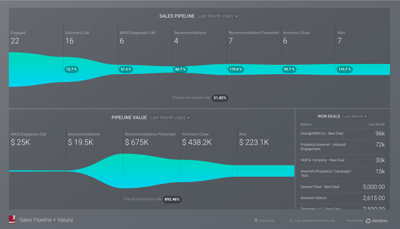
HubSpot Introduces The Flywheel: How To Use It To Drive Revenue Growth
You Can’t Market, Sell Or Service Without Understanding Your Prospects’ Buyer Journey
 HubSpot is innovating the software you need to get customers, take care of customers and grow your business. We’re innovating how you map tactics to each stage of the buyer journey, all the way from before prospects even know you exist to how you delight them as customers.
HubSpot is innovating the software you need to get customers, take care of customers and grow your business. We’re innovating how you map tactics to each stage of the buyer journey, all the way from before prospects even know you exist to how you delight them as customers.
It’s one continual journey that never stops. We spent the time to think through how to plan your attack at each stage, prioritize your efforts across the entire journey, map tactics to each stage, track your performance in each stage and optimize that performance over time.
Welcome to the Cyclonic Buyer Journey™. Let’s do more than just replace the funnel; let’s Smash The Funnel™ with a system for repeatable, scalable and predictable revenue generation.
Here’s HubSpot’s new flywheel graphic (and the story behind it) that shows the three steps required to care for and feed prospects, leads and customers. The faster it spins and the less friction, the more revenue you’ll generate. But this doesn’t answer the key questions: “What do I do to make it spin, and what do I do in each area to generate revenue?” We’ve got your answers.

The Cyclonic Buyer Journey™
Almost everyone has noticed that the old marketing and sales playbook doesn’t work like it used to. You can’t cold call and sell your way into sustainable, predictable and repeatable revenue generation. The old funnel isn’t representative of your prospects’ buying experience anymore.
Instead, you have to earn attention and get found by creating disruptive and compelling content, including your own company story. After you’ve earned that attention, you must nurture those prospects to continue the conversation while they proceed on their own journey.
Then, when they are ready to talk to you, consider acting as your prospects’ guide while their buyer journey continues, helping them to get educated around their purchase decision, so they feel like your company is the safe decision. Finally, you have to take great care of those new customers, and you have to delight them so they tell everyone about your company. Do that and you’ll be rewarded with a steady stream of revenue.
Now that might sound easy, but you have to do it at scale. This means it’s not enough for one person to be working like this. Your entire sales, marketing and customer services organization has to embrace these principles and change the way they execute all aspects of marketing, sales and service.
But we still have to execute marketing, sales and customer service playbooks. How do we know what to do and when to do it? How do we determine what’s going to produce the desired results? To help, we created a new journey graphic that we think better illustrates today’s prospect journey.
Take a look as we describe why this fits better today than the old traditional funnel.
First, you’ll notice that the new buyer journey isn’t linear. It doesn’t start at the top and flow down to the bottom to finish. In our opinion, the series of cycles means each stage includes a set of experiences.

If you do a good job in the awareness cycle, then you might move your prospect out and into the education cycle. If you don’t, your prospect might get stuck in that awareness cycle until additional information is provided or outside influences cause the prospect to progress. More on those influences in the next section.
Our research shows that in most cases, prospects move from cycle to cycle not in sequence but based on the environmental factors that influence them along their journey. Some of those factors include how you market to them, how your sales teams work with them and how your customer service reps take care of customers.
This explains why some prospects progress quickly and others progress more slowly. This means your content, website and lead nurturing work must be highly effective, data driven and perfectly designed based on your understanding of your prospects’ persona, pains and journey insights.
Also, you should notice the cycle that wraps around after the final decision. You have amazing opportunities to work with customers and introduce new products/services or project opportunities. You have an opportunity to upgrade the communication and how you incentivize them to be your advocate. After the sale is done, the process has to continue. The cycles continue to spin. The bigger cycle always spins.
What you don’t see in this graphic is that factors inside and outside of your control impact these cycles. While your prospect might be moving along quickly, when they go dark, are slow to respond or reach out with contradictory feedback, it’s likely that one of these outside influences is now affecting their ability to move through the series of cycles.
While you are not in control of these outside influences, you have to be smart enough to give the prospect an opportunity to share those inputs with you, so you can respond accordingly.
The biggest challenge is the sheer amount of information available to your prospects during their journey. They’re going to be confused, and that confusion slows down your process. You might not be aware that the CIO is now active in influencing your prospect’s decision. You didn’t identify the CIO and didn’t ask about their involvement, but now they are slowing down your prospect’s journey. You need your champion or contact person to give you that information, so you can adjust accordingly and then build into your process a point to make sure you don’t get caught unprepared again.
Your job is to position your company as the trusted source, your sales team as the guides and your service reps as advisors. If you do this well, all of that conflicting information will come back to you through your prospect, and you can help them work through that info and keep them moving forward.
The Marketing, Sales And Services Tactics Map

If you get it, then the next question you should be asking is, “What do I do about it?” The answer is start deploying tactics, tools and campaigns differently. You won’t see real revenue growth unless you do as many of these tactics as possible across all three areas.
As a CEO, you always want to know why marketing isn’t producing more leads, why sales isn’t closing more new customers and why customers aren’t happier. You’re asking those questions because the tactics are not deployed properly, you haven’t deployed the right tactics or you haven’t deployed enough tactics to move the needle.
Those questions are now, for the first time, answered here.
Pre-Awareness – These are the people who don’t know you, but you think they have the pains, problems and challenges your products and services solve. They’re not looking for you, but you want them to know about you. You want to create awareness for your company and your offerings. These are the tactics that map to this stage in their buyer journey.
- Strategic messaging, differentiation and story development
- Account-based marketing (includes data cleansing and appending, connect emails and engagement content, social and ongoing nurturing)
- Cold email marketing campaigns (purchased list or acquired list)
- Paid social media advertising
- Social media content creation and publication
- Banner advertising
- Retargeting banner ads
- Content syndication
- Affiliate marketing – working with partner organizations, networks or properties that have access to your targeted personas
- Influencer marketing
- Content publication on targeted sites/properties
- Events, trade shows and conferences, including speaking engagements
Awareness – These people are aware that solutions like yours exist, but they’re not yet convinced they need them. They might be looking, or this might be that little voice inside their head that continually gnaws at their psyche. They’re starting to look but not nearly ready to buy or engage in any meaningful conversations with providers.
- Organic search engine optimization
- Paid AdWords on search engines
- Website design
- Website pillar pages (for search)
- Conversion rate optimization
- Visitor experience optimization on the website
- Content publication
- Social media marketing
- Content marketing – production of disruptive, educational and compelling content (persona-appropriate varieties and formats, with an emphasis on video, podcasts and interactive content)
- Graders and assessments to uncover issues prospect doesn’t know they have
- Blogging and guest blogging
- Email marketing
- Affiliate marketing
- Lead scoring
Education – These people are proactively looking to educate themselves and their organizations around the options available to them. They may not be ready to buy, but they are active in their desire to be smarter about their options.
- Content marketing – very heavy in this stage
- Podcasting
- Video marketing
- Infographics
- Research studies
- Lead nurturing
- Email marketing
- Website design
- Website pillar pages (for education)
- Chat for conversion
- Chat for intent
- Chat for education and questions
- Conversion rate optimization
- Webinars
- Live events (company specific, like inbound)
- Blogging and guest blogging
- Influencer marketing
- Social media marketing and content publication
- Advocacy (people telling other people)
- Lead scoring
Consideration – These people have decided to buy and are now starting to evaluate the options available to them. They’re not educating themselves on the alternatives but rather on the various solutions available to them.
- Influencer marketing
- Blogging and guest blogging
- Video marketing – customer stories
- Content publication on social media
- Content syndication
- Content marketing (make or buy content, in-house or outsourced content)
- Case studies and success stories
- Advocacy (people telling other people)
- Reviews, directories
- Lead scoring
Evaluation – This is typically where marketing hands off the lead to sales. These people have narrowed their options down to a small handful. It could be 10 possible options or three finalists. They are pitting one option against the others, hopefully based on a set of requirements, but they are evaluating a smaller set of options.
- Website design
- Content marketing (content evaluation, comparisons, proposal templates, questions to ask)
- Case studies and success stories
- Lead nurturing
- Email marketing
- Reviews
- Sales process design
- Content for the sales team
- Email templates for the sales team
- Sales training
- Sales coaching
- Lead scoring
Rationalization –They’ve narrowed their options down even further. They may have even made the emotional decision to go with one specific provider but need to make sure the details associated with that option line up with their requirements. Details that get worked out in this stage include payment terms, contract details, team structure and a refined set of expectations.
- Sales process
- Sales email templates
- Advocacy
- References
- Reference reel – video
- ROI models
- Delivery content – what the customer experience feels and looks like (expectation setting)
Decision-Making – The actual final decision is made, and contracts, proposals or agreements are signed.
- Sales process
- Proposals
- Recommendations decks
- Contracts, agreements
Ongoing Delivery – Now it’s time to deliver; whatever you promised must be provided (and then some). Over-delivering is key to turning people into raving fans and advocates of your business.
- Advocacy, references
- Customer surveys
- Active referral program
- Knowledge base creation for customer service
- Upsell and cross-sell customer marketing programs
- Customer service communication (email templates)
You’ll notice that tactics appear in multiple stages and versions of tactics also appear in multiple stages. That’s because a tactic like lead nurturing can help you in almost all of the stages, and you need to consider versions of tactics depending on the specifics of your customers, your company, your industry and your solutions. These maps are like the DNA of a human being; no two are the same, yet they all have similar structures.
The Analytics And Dashboard Map
 Marketing, sales and customer service are now scientific practices. Science deals in data, numbers and quantitative outcomes. You get the data, you track it and you know how you’re doing in real time.
Marketing, sales and customer service are now scientific practices. Science deals in data, numbers and quantitative outcomes. You get the data, you track it and you know how you’re doing in real time.
Just like you map the tactics, you map the data you need to be tracking. You create dashboards for each of the stages and track the appropriate KPIs in each stage. As the metrics improve, the cycle spins more quickly and revenue follows.
Here’s the map for metrics in the Cyclonic Buyer Journey™.
Pre-Awareness – Remember, you know them, but they don’t know you.
- Total available market
- Total targeted accounts and total targeted people in those accounts
- Connect rate with those targeted people
- Engagement rate with those targeted people
- Number of new contacts
Awareness – These people are aware of solutions like yours and might be looking right now.
- Visitors to your website
- New visitors to your website
- Bounce rate
- Average time on site
- Average number of page views per visitor
Education – These people are active in getting educated around solutions to their pain. It might be you and your solutions, or it might be alternatives. But regardless, they are actively engaged.
- Site-wide conversion rate
- Content performance data (CTA clicks, form performance, chat conversions)
- Webinar attendees
- Video views
- Subscribers to blogs, video content and podcasts
Consideration – These people are considering options like yours. They haven’t narrowed down their options, but the decision to buy has been made.
- Percentage of total leads with a high lead score
- Conversion rates on consideration-stage content
- The number of inquiries to the sales team for existing leads
- The number of chat conversions to sales
Evaluation – These people have narrowed their options and are evaluating a set number of possible solutions; it’s a flat-out competition between the options at this stage.
- Sales-qualified leads to sales opportunity conversion rate
- Average lead scores for sales opportunities
- Number of active sales opportunities
- Dollar value of sales opportunities
- Total pipeline value
Rationalization – These people have decided; they’re emotionally connected to one option and they’ve made their decision but still need to dot the I’s and cross the T’s. Procurement might even be brought in at this point to negotiate the contract.
- Number of opportunities in imminent close
- Number of proposals/agreements submitted
- Percentage of sales opportunities vs. proposals submitted
Decision-Making – They’ve picked you or someone else at this point. You won or you lost. The final decision is during this stage. Paperwork is signed and kickoff meetings are scheduled.
- Percentage of proposals submitted vs. new customers (close rate)
- Percentage of sales opportunities vs. new customers
- Length of the sales cycle (days)
- Number of new customers
- Revenue from new customers
Ongoing Delivery – These people are waiting for everything you promised and more from the sales process to materialize. It’s time to impress, over-deliver and make as many raving fans as possible.
- Net promoter score
- Advocacy rate (percentage of customers who are advocates)
- Average revenue per customer
- Renewal rate
- Add-on sales revenue
- Number of customer service inquiries
Modeling Expected Results
.jpg?width=400&name=ThinkstockPhotos-636332456%20(1).jpg) With the stages clearly defined, the tactics strategically mapped and the performance metrics set, it’s easy to start modeling expected results. The more tactics you’ve deployed and the more investment applied at each of the stages, the more you should expect from your program.
With the stages clearly defined, the tactics strategically mapped and the performance metrics set, it’s easy to start modeling expected results. The more tactics you’ve deployed and the more investment applied at each of the stages, the more you should expect from your program.
Of course, your starting point is key, too. If you’re only seeing 100 visitors a month to your website, don’t except to be at 1,000 visitors or 10,000 visitors in a few weeks. But if you start with 10,000 visitors a month and apply the same set of tactics, you should expect to see a bigger lift in a shorter time frame.
You can model expected results at each stage of the funnel and apply multipliers based on the tactics and investment applied across every stage. We’ll apply our experiential data, your company data and your industry benchmark data to create a revenue model personalized and customized for your business. If you’re doing this on your own, you won’t have experience and industry benchmark data, but you should be able to use your baseline data to optimize your own program performance month over month.
This shows you exactly where you are today as well as where you should expect to be next month and 12 months in the future. You then use this data to keep tabs on your own marketing, sales, service and overall company revenue growth performance. Do this correctly and you have a revenue performance model to help you build out and optimize your revenue generation machine.
The Technology Map
What we’re describing here is complex, and the technology available today helps you automate, implement, analyze and optimize this complicated set of executable tactics. Think about the differences between cars today and cars from 20 years ago. Today, all of our cars are run by computers and technology that optimizes braking, gas consumption, engine operation, driver comfort and more. You’ll need the same help optimizing your marketing, sales and services experiences.
 You’ll find basic tools for basic execution, such as HubSpot, Marketo, Eloqua and Pardot for marketing automation, HubSpot, Salesforce.com and Infusionsoft for CRM, and Zendesk and other service solutions for ticketing and customer service. These tools might be enough for your business, but if you need advanced support for any aspect of that buyer journey, then you need to consider adding advanced features on top of the basic tools.
You’ll find basic tools for basic execution, such as HubSpot, Marketo, Eloqua and Pardot for marketing automation, HubSpot, Salesforce.com and Infusionsoft for CRM, and Zendesk and other service solutions for ticketing and customer service. These tools might be enough for your business, but if you need advanced support for any aspect of that buyer journey, then you need to consider adding advanced features on top of the basic tools.
For example, you may want to use Seventh Sense for email marketing. If you’re going to lean heavily on email marketing, the advanced send features available in Seventh Sense help you know what time to send emails to specific individuals based on their individual performance. If someone is more likely to open and click through your email if you send them at 7 p.m. on Saturday, then you should be actively managing that send intelligence to optimize your campaigns.
If content marketing is a major part of your marketing strategy, Atomic Reach helps you leverage content performance data to create higher-converting content offerings. The software uses advanced analytics and AI to help you create content that converts based on your specific prospect data.
If you’re all-in on chat and conversational marketing, tools like Drift help you optimize all of your visitors’ experiences on your website. You answer their questions, gain intent data and respond to them immediately, turning a visitor into a sales opportunity in seconds instead of weeks or longer.
By going through each stage in the Cyclonic Buyer Journey™, looking at each of the tactics you plan to deploy and the performance metrics you need to move, and then leveraging the best technology for each of those stages, you now have a methodology that is guaranteed to produce the necessary impact on revenue to take your company from point A to point B.
If you have big lofty revenue goals, expect to invest accordingly. If you have more modest revenue goals, perhaps a more modest investment with fewer tactics and less technology will suffice. Regardless, today you are in a unique position to be able to (for the first time) map out your entire revenue generation strategy from beginning to end, removing the uncertainty and making it 100% transparent to you and your entire team.
However, a word of caution: If you try to skip, short cut or jump over any of the steps outlined here, proceed at your own risk. You’ll be tempted to start with tactics without mapping out your prospects’ buyer journey. You’ll be tempted to collapse certain parts of the buyer journey. You’ll be encouraged to skip over the data and metrics component.
You’ll also be swayed by less experienced experts to think this approach isn’t needed. There is a reason why so many experts are unable to help their clients get true results. Doctors follow a set of surgical procedures because it produces a set of repeatable results. This is no different. Don’t be distracted from your goal — repeatable, sustainable, scalable and predictable revenue. For the first time in the history of business, the answer is in front of you.
Square 2 Marketing – Revenue Is Earned Through Experience, Methodology And Insights!

CEO and Chief Revenue Scientist
Mike Lieberman, CEO and Chief Revenue Scientist
Eliminate Hit-or-Miss Marketing Moves
Get advice, tips, tools and guidance to generate more leads for your company in this weekly email newsletter.



Eliminate Hit-or-Miss Marketing Moves
Get advice, tips, tools and guidance to generate more leads for your company in this weekly email newsletter.













